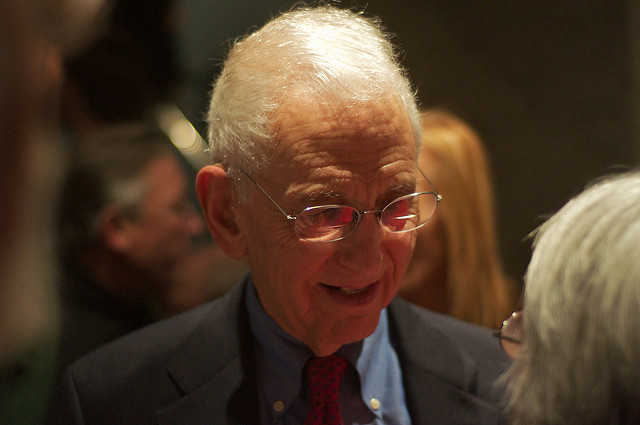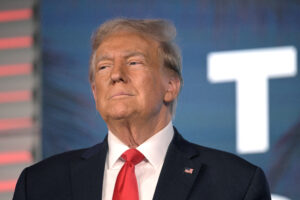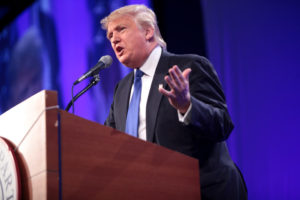Daniel Ellsberg: The Cold War Was Based on a Lie
The famed whistleblower and former RAND corporation employee reflects on a discovery that could have altered the course of history. Whistleblower and "The Doomsday Machine" author Daniel Ellsberg. (Steve Rhodes / Flickr)
Whistleblower and "The Doomsday Machine" author Daniel Ellsberg. (Steve Rhodes / Flickr)
What follows is a conversation between “The Doomsday Machine” author and whistleblower Daniel Ellsberg and Paul Jay of the Real News Network. Read a transcript of their conversation below or watch the video at the bottom of the post.
PAUL JAY: Welcome back to Reality Asserts Itself. I’m Paul Jay. We’re continuing our discussion with Daniel Ellsberg.
Daniel, in 1959, 1960, there is a race because we understand, we the population understood, that there was a missile gap. We were told. That the Russians had something between 40 and 60 intercontinental ballistic missiles which they could either first strike or second strike the United States. There had to be a great race to create more and more ICBMs here. The possibility, the discussions inside the military, the strategic planning is all based on a potential, really, first strike, because most people believe this number of, the numbers of ICBMs that Russia, the Soviet Union had that was such a threat. And you made a rather alarming discovery.
DANIEL ELLSBERG: Well, first of all, the estimate of 40 to 60- which was pretty much in 1962 at the time of the missile crisis based on a lot of satellite photography- was much lower than was estimated earlier, from ‘58, ‘59, ‘60. The Air Force had a higher estimate. Even the CIA official estimate in 1961 was well over 100. I think was like 120. The State Department estimated like 160. The Air Force was much higher than that. And in August of 1961, the then-commander of Strategic Air Command, I was told, when I was at Omaha at the base there- that was Thomas Power- believed that there were then 1000 Soviet ICBMs. This was the time when the estimate was much lower, as I say; between 120 and 160. But 1000 is what he believed.
Now, if you look back and say, how could I have been working on plans of this nature? It wasn’t to carry out a nuclear war. I thought that would be catastrophic in any case. I was shocked when I learned that the Joint Chiefs understood how catastrophic it would be; hundreds of millions. But I did believe that it would be catastrophic, and that the way to deter a Soviet surprise attack was by presenting them with the assured capability of destroying a large part of their society. For deterrence. That nothing else would do. That was because my colleagues and I accepted, and certainly the intelligence communities, perceived and projected the image of Stalin’s Russia and then his successors as Hitler with nuclear weapons, and that they would bend no effort- they would bend every effort to achieve the ability to destroy us, or at least to blackmail us into submission. And since they had achieved ICBMs launching faster than we had- that was almost the one point on which we didn’t lead the arms race- it was assumed that they would move ahead quickly, build a lot of ICBMs so they would have this capability against our bomber bases before we had ICBMs, intercontinental ballistic missiles.
It was taken for granted by my colleagues that we were greatly outnumbered; the so-called missile gap. And Eisenhower actually didn’t accept that, but he was regarded as a doddering old man who was playing golf all the time, and simply not with it. We really looked down on him, because the Air Force thought that was almost the [treasonable] estimate which was also being made by the Army and Navy on the same basis of data.
PAUL JAY: What was their estimate?
DANIEL ELLSBERG: Little data. And theirs was ‘a few.’ Well, that’s pretty different from 160, or let alone 1000. So my Air Force colleagues thought the Army and Navy were lowballing the estimate so as to keep a ceiling on the Air Force budget for missiles in their favor. [Were] literally being treasonous. That was a word I did hear. I haven’t heard it much until recently, now.
PAUL JAY: That the Army and Navy were being treasonous?
DANIEL ELLSBERG: The Army and Navy were doing this. Now, in late- just after the estimate of 1000 in August, in September we finally got full coverage of the ICBM possible sites in Russia with our satellites, which were a very secret program, which my colleagues at Rand were not privy to at Top Secret level. It was higher than Top Secret. There were only a handful of people at Rand who had-
PAUL JAY: And why were you? Why did you have access?
DANIEL ELLSBERG: I didn’t. I was in the Pentagon. I didn’t have a clearance. But people made a security lapse, in a way. I was there, and saw a new estimate. And was told in a security breach, in a way, which was almost unprecedented. I never- not before or after people told me something that I didn’t have the clearance for. And I couldn’t share it with Rand, because we would all have lost our access had I spread this around. But the news was this: that what the Soviets had at that time was four ICBMs.
PAUL JAY: Four.
DANIEL ELLSBERG: Not 40, not 160, not 1000, but 4.
Now, that remained, by the way, relatively unknown to the public very late in the game. Even Richard Rhodes’ excellent book, his second book on the nuclear program, on the H-bomb, many years later was still saying that what they had then was not what had been predicted, but only 40. But that’s ten times more than they actually had. They had essentially nothing. They had not sought a first strike force at all, which they could have had with their original missiles, inefficient and large and clumsy as they were. They could have had a first strike [crosstalk].
PAUL JAY: So how does that fit with the narrative? The Russians are coming, the Soviet threat. They’re going to take over the world.
DANIEL ELLSBERG: It should have led to a whole reconsideration of the framework here, because it wasn’t just that they couldn’t afford to. they clearly hadn’t felt that was high priority to have that capability. The notion that they were aching to take over Western Europe at the earliest possibility, or to destroy the U.S. as their main rival, was clearly something wrong with it. And it was actually wrong.
But as Ray Garthoff, a high intelligence person, leader and ambassador, wrote, he was rapporteur for a group that was saying, what’s the significance of the new estimates for an interagency group, intelligence group that was doing that? And he reported much later in a little Brookings Institution book that the premise of their study was do we have enough? Are our forces adequate in face of the new estimates? He said the answer was yes, they’re adequate. We were planning for 1000 Minuteman or more. The Air Force wanted 10,000 Minuteman missiles; solid fuel Minutemen missiles. To argue for 10,000, or even 1000, was not so easy when the Russians had 4. But they were adequate. It was not- it was not too few. As Garthoff points out, no one asked the question, could there be too many? Do we need this many? And could we reconsider our whole approach of whether it’s possible to negotiate a missile test ban, or testing an ICBM, an H-bomb test ban?
It was taken for granted that these Hitlers with nuclear weapons would not negotiate seriously any more than Hitler would have, and Hitler would not. The Soviets would have, by almost everything we know now. Would have been happy. What this indicated was they had built the weapons even without an agreement that limited arms. So if we were willing to limit ours, which we weren’t, could they have been kept down to a very low number? I think very likely so. We now know that Khrushchev, in this respect, was like Gorbachev. He wanted to cut down spending on the military all together, and nuclear weapons in general. And yes, he almost certainly would have done that. we didn’t think of even- actually, they proposed things like that- but didn’t take that seriously at all. We needed the missiles. We wanted the missiles, in part for political economic reasons in 1961.
As the man who examined me for my Ph.D. orals, economics professor Arthur [Smittys], was a consultant on economic matters to President Kennedy. And he was telling him, at a time when the recession threatened, the Minuteman program is something you can turn up. Or go down, if you wanted to cool off the economy. It’s a Keynesian lever, here. And McNamara at the same time was saying, I really can’t justify more than, say, 400 missiles, because that will pretty well annihilate the Soviet Union. But if I go for less than 1000 we will be impeached. And you can impeach not only presidents, but SecDefs. And they couldn’t, for political reasons, they thought, turn off that production line, get it down. And so we went for 1000. Actually, he was going- he had 1000 in mind. He didn’t admit that to the Air Force. The Air Force wanted a minimum of 1600. He was getting down to 1400. But he always had in mind that at the end a nice round 1000 was what he was aiming at. But the others would have been in full revolt to Congress had he said that at the time.
PAUL JAY: In his book Doomsday Machine, Daniel Ellsberg writes:
“I’ve gone into all this to emphasize that the credibility of this new estimate—fantastic, inherently incredible to anyone who had been relying on Air Force estimates or even CIA estimates (anything but Army and Navy estimates)—depended on knowledge of a kind of information that most people in the national security field, inside and outside the government, had no inkling existed. From the internal leaks—“unauthorized disclosures”—to me within the bureaucracy, I did believe it, even though it totally contradicted the fundamental basis for my concerns and work for the past several years.
It wasn’t just a matter of numbers, though that alone invalidated virtually all the classified analyses and studies I’d read and participated in for years. Since it seemed clear that the Soviets could have produced and deployed many, many more missiles in the three years since their first ICBM test, it put in question—it virtually demolished—the fundamental premise that the Soviets were pursuing a program of world conquest like Hitler’s.”
Your support matters…
Independent journalism is under threat and overshadowed by heavily funded mainstream media.
You can help level the playing field. Become a member.
Your tax-deductible contribution keeps us digging beneath the headlines to give you thought-provoking, investigative reporting and analysis that unearths what's really happening- without compromise.
Give today to support our courageous, independent journalists.






You need to be a supporter to comment.
There are currently no responses to this article.
Be the first to respond.